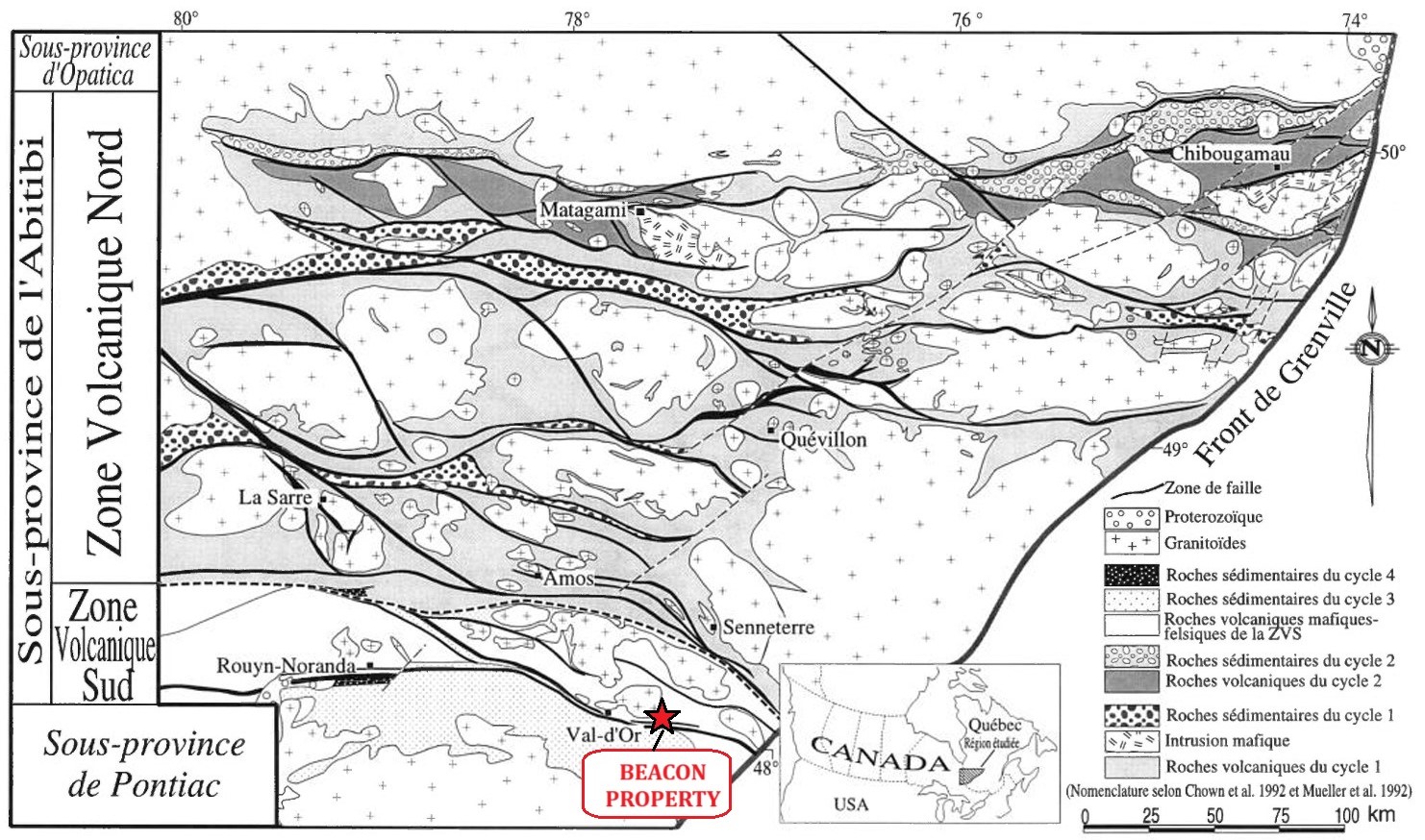Beacon #1
Location, Access, Description
The Beacon property is located about 18 km east of the town of Val-d’Or, in the Abitibi-Temiscamingue Administrative Region, western Quebec (Figure 1). The property is composed of 2 contiguous mining claims totalling 12.29 Ha in Louvicourt township (NTS 32C04), in the Vallée-de-l’Or County. These titles are fully owned by Globex mining entreprises inc. The property is easily accessible by road from Val-d’Or, driving about 17 km on Highway 117 south then turn left on Pascalis gravel road on 1.3 km toward north. The former Beacon No.2 gold mine is located about 1.6 km SW of the property, while the former Louvem (Zn) and Louvicourt (Cu) mines are located 2.2 km and 3.1 km SE, respectively.
Topography is quite flat with elevations comprised between 330m and 340m above sea level. The Pascalis gravel road crosses through the entire property in a N-S direction. The property is covered with mixed forest of coniferous (black spruce, jack pine) and leafy trees (aspen, birch). Several areas of recent deforestation are observed in the western part of the property and could expose outcrops. A swamp is present just west of the Beacon property.
Many commodities can be found in Val-d’Or regarding contractors and skilled labor, equipment rental, as well as sleep and food accommodation of remote workers. A hydro power line is present on the south roadside of Highway 117, about 1.2 km south of the property.
Geology and Mineralization
Regional Settings
The Beacon property is located in the Archean Abitibi Greenstone Belt of the Superior Province of the Canadian Shield. Rocks of the Val-d’Or region consist of an Archean volcano-sedimentary sequences composed of ultramafic, mafic and felsic volcanic and volcanoclastic rocks (2714 ±2 Ma to 2704 ±2 Ma; Wong et al., 1991; DV97-01; DV98-05; DV99-03) separated by narrow sedimentary rock bands. Numerous Archean synvolcanic, syntectonic and late-tectonic intrusions set in place within both Archean volcanics and sediments (MB94-55). All Archean rocks of this area have been verticalized during the Kenorean orogenesis that occurred about 2.5 Ga ago.
In the area of the Beacon property, the synvolcanic Bourlamaque Batholith (2,699 ±1 Ma – Wong et al., 1991), hosting a number of producing and past producing gold deposits, intrudes the ENE trending, steeply north dipping, overturned sequence of mafic and felsic submarine volcanic & pyroclastic flows of the Val-d’Or Formation (Louvicourt Group) and Jacola Formation (Malartic Group).
The Cadillac-Larder Lake (CLL) fault is the major regional feature of the area, extending on more than 250 km in a E-W strike. Numerous showings and deposits have been uncovered along this prolific structure in both Quebec and Ontario Provinces. The CLL fault strikes 7 km south of the Beacon property and it separates the rocks of the Abitibi Sub-province in the north from those of the Pontiac Sub-province in the south. The Manitou fault strikes 800 m south of the property.
Regional metamorphism is at the greenschists grade and locally reaches the lower amphibolite grade around large Archean intrusions. Proterozoic diabase swarms cut through every Archean rocks.
Property Geology
The NW quadrant of the Beacon property is underlain by the Bourlamaque Batholith, composed of diorite, quartz-diorite and tonalite. The central and dominant part of the property is underlain by sheared, hydrothermally altered (sericitized, silicified and locally chloritized), steeply north dipping felsic, intermediate and mafic flows and pyroclastics (tuffs/lapilli tuffs) of both the Jacola and Val-d’Or formations.
The south extremity of the property is underlain by locally sheared, quartz vein injected and chloritized feldspar porphyritic diorite (Figure 4) which represents the northern limit of the “Connell Plug”, a locally gold mineralized small mafic stock thought to be an apophysis of the Bourlamaque Batholith (MB2000-09).
Metallogeny
The Abitibi Greenstone Belt hosts several world-class deposits and has produced more than 210 Moz Au historically (Dubé and Mercier-Langevin, 2019), which makes it one of the largest and richest in the world. The Larder Lake – Cadillac fault, located about 7 km south of the property, is one of the major gold metallotect in the Abitibi Sub-province.
The Bourlamaque Batholith, interpreted as synvolcanic to the surrounding volcanics (MM82-04), generally shows thrust faulted contact with the mafic and felsic volcanic units of the Val-d’Or Formation along its southern contact zone, which is the focus of much of the gold mineralization in the area as along the south margin of the batholith as exemplified by such deposits as the Beaufor, Beacon I, Beacon II (D’Or Val Mine), Wrightbar and Dumont Mine.
The Beacon property covers the eastern extension of Beacon #1 gold vein system which is associated with the past producing D’Or Val mine (historical non 43-101 Resource 493,800 tonnes grading 7.20 g/t Au). Gold mineralization is found inside shear zone hosted quartz-carbonate-tourmaline veins with pyrite and minor chalcopyrite, hosted in the Bourlamaque granodiorite Batholith.
The Val d’Or Formation hosts a number of past producing VMS deposits including the Louvicourt deposit (Past Production of 13.87 Mt @ 3.52% Cu, 1.53% Zn, 25.88 g/t Ag and 0.92 g/t Au – DV 2004-01) 3.5 km ESE of the property, the Louvem deposit (Past Production of 2.35 Mt @ 0.21% Cu, 5.9% Zn,
34.29 g/t Ag, 0.69 g/t Au – Sigeom), 2 km ESE of the property, as well as several other small copper rich VMS occurrences located close to the east of the property.
HISTORY
The oldest work listed in the area of the Beacon property dates back to the early 1930s. Numerous exploration campaigns have been carried out by exploration companies in the vicinity of the Beacon property throughout the years. These works succeeded in establishing favorable environments for both VMS (Val-d’Or Formation) and Au (Bourlamaque Batholith) mineralizations.
The Beacon has been sporadically explored during the past. Prospection, field mapping, grab sampling, trenching and sampling campaigns as well as limited geophysical surveys have been undertaken during the 30’s. The interest was renewed in the 1970s and 1980s with magnetometry and EM surveys, but still no diamond drilling directly on the Beacon property.
In summer 2011, Globex completed a ground magnetometer survey (GM66272) and geological mapping on the Beacon property prior to implementing a single 426 meter diamond drill hole (GM66271). Mapping identified a 2m to 6m wide high strain zone (chl/ser/iron carb schist) with multiple 5-10cm wide grey qtz/minor Py veinlets (shear & dilation type veins) developed at the contact between the feldspar porphyritic diorite (to the south) and sericitized felsic volcanic (to the north). Drilling tested for gold mineralization east and along the interpreted structural/lithological strike direction from the small past producing Beacon #1 gold mine. The drilling was successful in encountering a new zone of gold mineralization at a previously unexplored vertical depth of 260 m, with assays up to 5.28 g/t Au over 2.9 m, including 8.57 g/t Au over 1.5 m.
In 2012, Globex implanted 3 additional DDH totalling 900 m (GM68863) in order to test extensions of the known gold zones on the adjacent property with the Beacon 1 gold deposit and the intersection identified during the 2011 Globex program (Figure 4). Best intersections included 35.76 g/t Au / 1.05m (Beacon 12-01), 13.11 g/t Au / 2.0m (Beacon-12-02) and 1.99 g/t Au / 1.5m (Beacon 12-03). Mineralized structures are interpreted to be steeply dipping and thus exploration at greater depth could still be undertaken.
Resources and Potential
Limited exploration has been carried out in the past on the Beacon property, despite the presence of numerous gold and base metals showings in the immediate vicinity. Favorable geological environments have been identified in this area for both volcanogenic massive sulphides and orogenic gold mineralization : massive sulphide lenses (VMS) are known in felsic volcanics and volcanoclastics of the Val-d’Or Formation east and west of the property, while auriferous qz-cb-tourm veins have been described all along the southern edge of the Bourlamaque Batholith.
Both these metallotects are present on the Beacon property but only four (4) DDH have ever been implemented on the property and intersected strongly anomalous sections suggesting that Au mineralization is still open at depth. No exploration has been undertaken since Globex’s drilling in 2012.
The Beacon property therefore hosts a strong potential for new Au and base metals discoveries. It is thus strongly recommended to proceed to a complete compilation of historical work done on the Beacon property and its immediate surroundings in a GIS. Particular attention shall be paid to geophysical (Mag, EM and IP) surveys since mineralization in this area is generally associated with disseminated to massive sulphides. Every coincident anomaly between two or more methods should then be investigated in prospection and rock stripping.
Depending on results of these works, DDH would be required.



